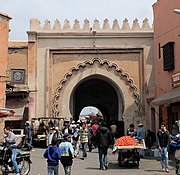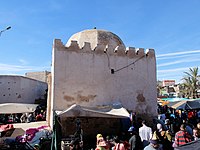Bab el-Khemis (Marrakesh)
| Bab el-Khemis | |
|---|---|
باب الخميس | |
 | |
 | |
| Former names | Bab Fes |
| General information | |
| Type | city gate |
| Architectural style | Almoravid, Moorish, Moroccan |
| Location | Marrakesh, Morocco |
| Coordinates | 31°38′22.1″N 7°59′8.2″W / 31.639472°N 7.985611°W |
| Completed | circa 1126 |
Bab el-Khemis (Arabic: باب الخميس, lit. 'gate of Thursday') is the main northern gate of the medina (historic walled city) of Marrakesh, Morocco.
History and location[edit]
The gate is located in the northern/northeastern corner of the city walls and dates back to around 1126 CE when the Almoravid emir Ali ibn Yusuf built the first walls of the city.[1][2] It was originally known as Bab Fes ("Gate of Fes"), but this name was apparently lost during the Marinid era.[1] The gate underwent a significant renovation in 1803–04 on the orders of Sultan Moulay Slimane, noted by a marble inscription found inside.[1][3]
The gate's current name (el-Khemis) refers to the souk or open-air market which historically took place here every Thursday (al-Khamis in Arabic).[3] Nowadays, the market continues almost all week right outside the gate,[4] while a permanent flea market, Souk al-Khemis, has been constructed a few hundred meters to the north.[5][6] Also just outside the gate is a qubba (domed mausoleum) housing the tomb of a local marabout or Muslim saint.[4]
Architecture[edit]
The gate's outer entrance is flanked on either side by square bastions. The gate's passage originally consisted of a bent entrance which effected a single 90-degree turn; one entered the gate from the north and then exited westwards into the city.[1][3] According to legend, the door leaves of the gate were brought from Spain by a victorious Yusuf ibn Tashfin.[4][1] During the Almohad period, the gatehouse was expanded such that its passage effected three more right-angle turns before exiting southwards. This gave it a similar form and layout to several other major Almohad gates such as Bab er-Rouah.[3] The outline of the gate's original exit, now walled-up, can still be seen in its interior western wall.[3]
At some point in the 20th century, the inner wall of the passage was opened up to allow a straight passage directly through the gate in order to facilitate the heavy traffic in the area, resulting in the current form of the gate.[1]
-
The outer (northern) facade of Bab el-Khemis
-
The inner (southern) facade of Bab el-Khemis
References[edit]
- ^ a b c d e f Allain, Charles; Deverdun, Gaston (1957). "Les portes anciennes de Marrakech". Hespéris. 44: 85–126. Archived from the original on 2021-02-28. Retrieved 2020-09-09.
- ^ Deverdun, Gaston (1959). Marrakech: Des origines à 1912. Rabat: Éditions Techniques Nord-Africaines.
- ^ a b c d e Wilbaux, Quentin (2001). La médina de Marrakech: Formation des espaces urbains d'une ancienne capitale du Maroc. Paris: L'Harmattan. ISBN 2747523888.
- ^ a b c Parker, Richard (1981). A practical guide to Islamic Monuments in Morocco. Charlottesville, VA: The Baraka Press.
- ^ Miller, Ashley (2014-11-10). "Flea Market in Marrakech: Bab El Khemis". Flea Market Insiders. Retrieved 2020-05-25.
- ^ "Bab Khemis: the flea market in Marrakech". Riad Jaune Safran (in Italian). 2017-03-03. Retrieved 2020-05-25.



